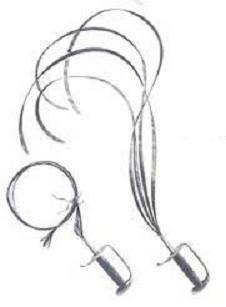 | ||
Length approx. 121.92–167.64 cm (48–66 in) | ||
The urumi (Malayalam: ഉറുമി urumi;Tamil: உறுமி, "urumi" or also known as சுருள் பட்டாக்கத்தி surul pattakahthi, lit. curling blade; Sinhalese: එතුණු කඩුව ethunu kaduwa;) is a sword with a flexible whip-like blade from India. Originating as Surul Pattakatti in Tamil Nadu of India, has been ignored or forgotten by generation, but the arts has been revived by Kerala Kalari Payat and practised until today. It is considered one of the most difficult weapons to master due to the risk of injuring oneself. It is treated as a steel whip, and therefore requires prior knowledge of that weapon. For this reason, the urumi is always taught last in Kalaripayattu, the South Indian martial art from the state of Kerala.
Contents
Term
The word urumi is of Keralan origin. In the state's southern region it is more commonly called a churuttuval, from the words for coiling or spinning (churutu) and sword (vaal). Alternative Tamil names for the weapon are surul val (curling sword) and surul katti (curling knife).
Anatomy
The urumi hilt is constructed from iron or brass and is identical to that of the talwar, complete with a crossguard and frequently a slender knucklebow. The typical handle is termed a "disc hilt" from the prominent disc-shaped flange surrounding the pommel. The pommel often has a short decorative spike-like protrusion projecting from its centre. The blade is fashioned from flexible double-edged steel measuring three-quarters to one inch in width. Ideally it should be the same as the wielder's armspan, usually between 4 feet to 5.5 feet. Multiple blades are often attached to a single handle. The Sri Lankan variation can have up to 32 blades and is typically dual-wielded, with one in each hand.
Use
The urumi is handled like a flail arm but requires less strength since the blade combined with centripetal force is sufficient to inflict injury. As with other "soft" weapons, urumi-wielders learn to follow and control the momentum of the blade with each swing, thus techniques include spins and agile maneuvres. These long-reaching spins make the weapon particularly well-suited to fighting against multiple opponents. When not in use, the urumi is worn coiled around the waist like a belt, with the handle at the wearer's side like a conventional sword.
